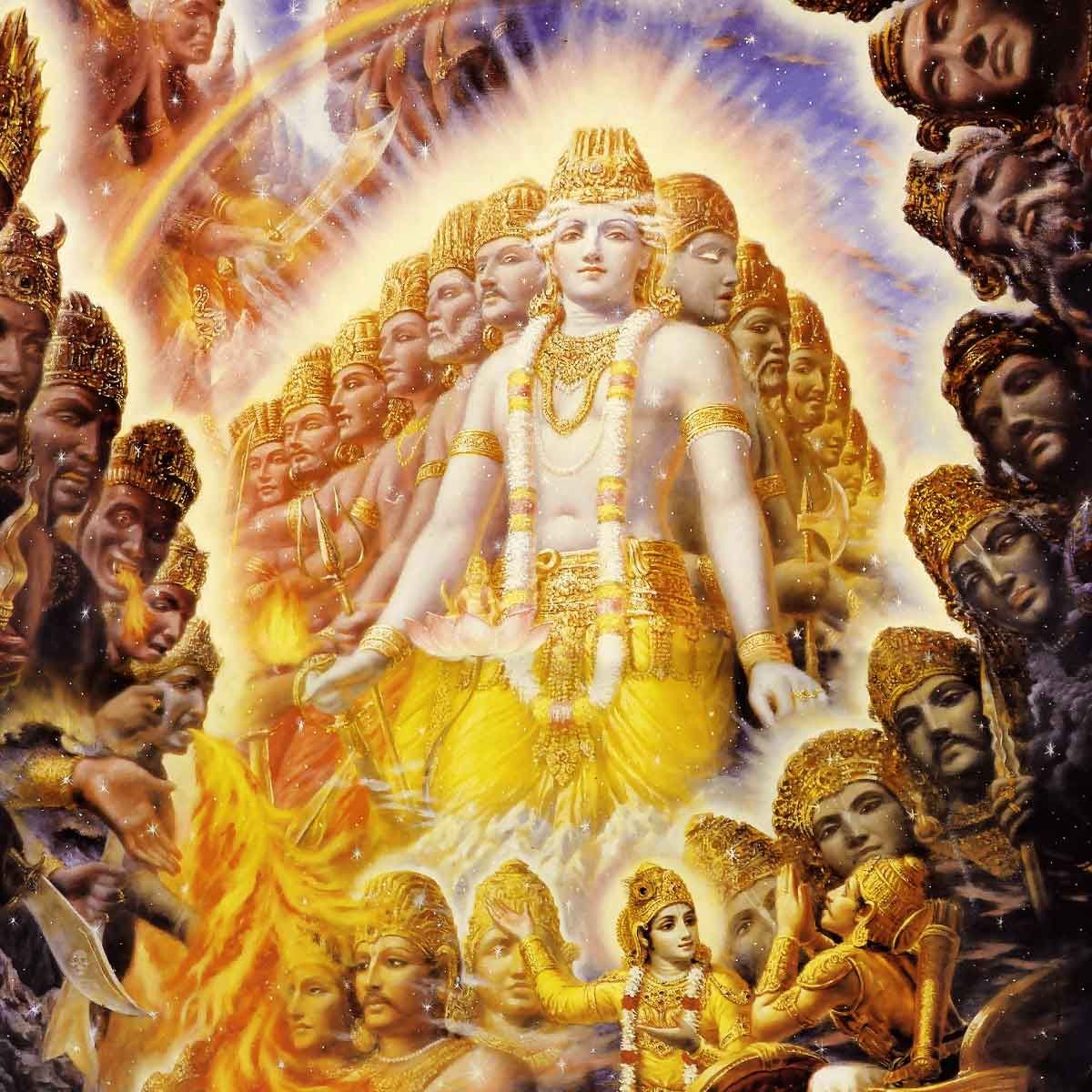MORE COVERAGE
Twitter Coverage
Satyaagrah
Written on
Satyaagrah
Written on
Satyaagrah
Written on
Satyaagrah
Written on
Satyaagrah
Written on
JOIN SATYAAGRAH SOCIAL MEDIA
"Man is made by his belief. As he believes, so he is": United States: 10,000 people gathered at Allen East Center in Texas, to recite the revered Bhagavad Gita together on the occasion of Guru Purnima, event was organised as Bhagavad Gita Parayan Yagya

In the heart of Texas, a spiritual event of grand proportions unfolded. Over 10,000 individuals, ranging from young children to the elderly, congregated at the Allen East Center to participate in a collective recitation of the Bhagavad Gita. This remarkable gathering, held on the auspicious occasion of Guru Purnima, was a testament to the enduring power and influence of spiritual traditions and the universal appeal of the timeless wisdom encapsulated in the Bhagavad Gita.
The event, aptly named the "Bhagavad Gita Parayan Yagya," was organized by the Yoga Sangeeta Trust America and the SGS Geeta Foundation. The recitation was led by the revered spiritual saint Pujya Ganapathy Sachidananda ji, whose presence added a profound sense of sanctity and reverence to the occasion.
The Bhagavad Gita, often referred to as the "manual for life," is a 700-verse Hindu scripture that is part of the Indian epic Mahabharata. Its teachings, delivered in the form of a dialogue between Prince Arjuna and the god Krishna, who serves as his charioteer, encompass a wide range of philosophical and ethical issues. The text is revered for its profound insights into the nature of reality, duty, righteousness, and the path to spiritual liberation.
Guru Purnima, the occasion that inspired this grand gathering, is a traditional Hindu festival dedicated to honoring gurus or spiritual masters. It is observed on the first full moon after the summer solstice, in the Hindu month of Ashad (July-August). This day is marked by expressions of deep gratitude and reverence towards spiritual and academic mentors, who are seen as the guiding lights on the path of spiritual and intellectual growth.
|
The tradition of Guru Purnima originated as a celebration of the great sage Maharshi Veda Vyasa, who is believed to have been born on this day. Vyasa is revered for his immense contributions to Hindu spiritual literature, including the editing of the four Vedas, the authoring of the 18 Puranas, the Mahabharata, and the Srimad Bhagavatam, and the commencement of the writing of the Brahma Sutras on Guru Purnima.
The Bhagavad Gita recitation in Texas was not just a spiritual event; it was a celebration of the universal human quest for wisdom, understanding, and transcendence. It was a testament to the enduring relevance of ancient wisdom in contemporary times and the unifying power of shared spiritual experiences. The sight of thousands of individuals, united in their devotion and reverence, reciting the sacred verses of the Bhagavad Gita, was a powerful reminder of the potential of spirituality to foster a sense of community, harmony, and shared purpose.
This event was a shining example of the power of spiritual traditions to transcend geographical boundaries and cultural differences. It demonstrated the potential of such gatherings to foster a sense of unity, mutual respect, and shared purpose among diverse groups of people. The Bhagavad Gita recitation in Texas was a testament to the enduring appeal of the Gita's wisdom and the universal human quest for spiritual growth and understanding.
Guru Purnima, a day of reverence and gratitude, holds a special place in the spiritual calendar. This sacred day, celebrated on the full moon (Purnima) in the Hindu month of Ashadha (June-July), is dedicated to the gurus or spiritual teachers who illuminate the path of knowledge and wisdom for their disciples. The term 'guru' in Sanskrit translates to 'dispeller of darkness,' symbolizing the role of the guru in guiding their disciples from the darkness of ignorance to the light of knowledge.
|
The Origins of Guru Purnima
The tradition of Guru Purnima has its roots in the ancient Indian spiritual culture. It is believed to have originated as a tribute to the great sage Maharshi Veda Vyasa, a monumental figure in Hindu literature. Vyasa, also known as Krishna Dvaipayana, is revered for his immense contributions to Hindu spiritual literature. He is credited with the compilation of the four Vedas, the authoring of the 18 Puranas, the epic Mahabharata, and the Srimad Bhagavatam. He is also believed to have commenced the writing of the Brahma Sutras on Guru Purnima, a work that forms the foundation of the 'Vedanta' philosophy.
Vyasa's birth anniversary is celebrated as Guru Purnima, and he is venerated as the 'Adi Guru' or the first guru in the Hindu tradition. The day is also known as 'Vyasa Purnima' in his honor. However, the significance of Guru Purnima extends beyond the celebration of Vyasa's contributions. It is a day dedicated to all gurus, spiritual and academic, who guide their disciples on the path of knowledge and wisdom.
|
The Significance of Guru Purnima
Guru Purnima is a day of deep spiritual significance. It is a day of gratitude, a day to express reverence and appreciation for the invaluable role that gurus play in shaping the lives of their disciples. The guru-shishya (teacher-student) relationship is a defining feature of the Indian spiritual and academic tradition, and Guru Purnima celebrates this unique bond.
On this day, disciples offer their respects to their gurus through various rituals and ceremonies. They seek their blessings and express their gratitude for the guidance and wisdom imparted by them. The day is marked by spiritual activities such as meditation, chanting, and the recitation of scriptures. Disciples also offer gifts to their gurus as a token of their respect and gratitude.
In the yogic tradition, Guru Purnima holds additional significance. It is believed that on this day, over 15,000 years ago, Shiva, the Adiyogi (the first yogi), transformed into the Adi Guru, the first guru. He began the transmission of yoga to the Saptarishis, the seven celebrated sages, thereby laying the foundation of the yogic science. This event is considered the advent of spiritual wisdom on earth, and Guru Purnima is celebrated as a reminder of this auspicious beginning.
Guru Purnima: A Timeless Tradition
Guru Purnima is a timeless tradition that continues to be celebrated with fervor and devotion. It is a day that underscores the importance of the guru-shishya relationship, a bond that is at the heart of the Indian spiritual and academic tradition. The day serves as a reminder of the value of knowledge, the importance of learning, and the role of the guru in guiding us on the path of wisdom and self-realization.
In the contemporary world, where knowledge is often equated with information, Guru Purnima invites us to reflect on the deeper meaning of knowledge. It reminds us that true knowledge is not merely theaccumulation of information but the cultivation of wisdom and discernment. It emphasizes the role of the guru in facilitating this transformative process.
In essence, Guru Purnima is a celebration of the quest for knowledge and the role of the guru in guiding this quest. It is a day to honor the tradition of learning and teaching, to express gratitude for the wisdom imparted by the gurus, and to recommit oneself to the pursuit of knowledge and self-realization.
The significance of Guru Purnima extends beyond the boundaries of India and the Hindu tradition. It is celebrated by Buddhists as the day when Gautama Buddha delivered his first sermon at Sarnath, Uttar Pradesh, India, after attaining enlightenment. The Jains celebrate it in honor of Mahavira, the 24th Tirthankara, who is believed to have attained Kaivalya (ultimate knowledge) on this day.
In the modern context, Guru Purnima has also come to be associated with the celebration of teachers and mentors in all fields – academic, artistic, or otherwise. It is an occasion to acknowledge the role of teachers in shaping minds and building futures.
In conclusion, Guru Purnima is a day of reverence, gratitude, and celebration. It is a day to honor the gurus who guide us on the path of knowledge and self-realization. It is a day to reflect on the value of knowledge and the importance of the quest for wisdom. Above all, it is a day to celebrate the timeless tradition of learning and teaching, a tradition that lies at the heart of human civilization.
 Support Us
Support Us
Satyagraha was born from the heart of our land, with an undying aim to unveil the true essence of Bharat. It seeks to illuminate the hidden tales of our valiant freedom fighters and the rich chronicles that haven't yet sung their complete melody in the mainstream.
While platforms like NDTV and 'The Wire' effortlessly garner funds under the banner of safeguarding democracy, we at Satyagraha walk a different path. Our strength and resonance come from you. In this journey to weave a stronger Bharat, every little contribution amplifies our voice. Let's come together, contribute as you can, and champion the true spirit of our nation.
 |  |  |
| ICICI Bank of Satyaagrah | Razorpay Bank of Satyaagrah | PayPal Bank of Satyaagrah - For International Payments |
If all above doesn't work, then try the LINK below:
Please share the article on other platforms
DISCLAIMER: The author is solely responsible for the views expressed in this article. The author carries the responsibility for citing and/or licensing of images utilized within the text. The website also frequently uses non-commercial images for representational purposes only in line with the article. We are not responsible for the authenticity of such images. If some images have a copyright issue, we request the person/entity to contact us at This email address is being protected from spambots. You need JavaScript enabled to view it. and we will take the necessary actions to resolve the issue.
Related Articles
- PM Modi inaugurates rebuilt Shankaracharya samadhi in Kedarnath and said ‘Adi Shankara brought life to a sleeping civilisation, awakened Bharat to rise above caste boundaries’
- Now Bharatwasi can see 3D visualization of Ram Mandir construction progress in detail through a video released by Shri Ram Janmabhoomi Teerth Kshetra Trust: Ayodhya
- Maa Annapurna returns to India after 107 years of exile in Canada: Murti will be installed at Kashi Vishwanath Mandir in Varanasi
- "Purify your hearts with the water of love of motherland in national temple, and promise that millions will not remain untouchables, but brothers and sisters": Swami Shraddhanand, who awoke Hindu consciousness
- "People without knowledge of their past history, origin & culture is like a tree without roots": Assamese Bhaona - traditional art with religious messages of truthfullness & dharma, created by 6th century saint-reformer Mahapurush Srimanta Sankardeva
- PM Narendra Modi inaugurated the Statue of Equality of Sri Ramanujacharya and emphasized 'Progressiveness does not mean detaching from one’s roots and that there is no conflict between progressiveness and antiquity.'
- Hinduism, Hindutva and the Contest for the Meaning of Hindu Identity: Swami Vivekananda and V.D. Savarkar
- RTI reply revealed that keys to the treasure room 'Ratna Bhandar' of Puri Jagannath temple which has a lot of gold, silver, and precious jewels donated by devotees and kings over the centuries have been ‘missing’ since 1970: Odisha
- Indonesia: Sukmawati Sukarnoputri, daughter of Indonesia's first president becomes a Hindu leaving Islam
- "Words on a page can hypnotize you if the rhythm is right": “Kalinga narthana” literally means “Kalinga dance” in Sanskrit, referring to a legend in which Shri Krishna, as a young boy, danced on the serpent Kaliya to stop him from poisoning Yamuna river
- Construction of Ram Mandir in Ayodhya is in full flow with the foundation work finished, main contractor for construction is Larsen & Toubro while Tata Consulting Engineers are project management consultant
- “In the struggle between stone & water, in time, the water wins”: Bharatiya Martial Art | Kalaripayattu is the father of all martial arts in the world, the existence of Martial arts in India for over 3000 years can be proved by its mention in the Vedas
- The Balliol college at the University of Oxford has dedicated a new building after Dr. Lakshman Sarup, the first candidate at Oxford to pass his thesis for a Doctorate of Philosophy (DPhil) degree on Sanskrit treatise on etymology
- A Different 9/11: How Vivekananda Won Americans’ Hearts and Minds
- Temple city Madurai grandly celebrated the Chithirai festival, devotees thronged streets, got darshan of deities Meenakshi, Sokkanathar, and Kallazhagar: “Govinda” “Hara Hara” chants reverberated in Madurai with pomp

























